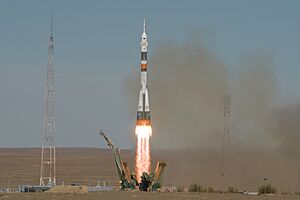Soyuz MS-10 facts for kids
The Soyuz MS-10 was a special space mission. It was meant to carry astronauts to the International Space Station (ISS). However, something went wrong shortly after its launch on October 11, 2018. The mission had to stop early, lasting only about 30 minutes.
This flight was the 139th time a Soyuz spacecraft had flown. It was supposed to take two crew members for Expedition 57 to the ISS. But just a few minutes after the rocket lifted off, there was a problem. A part of the rocket, called a booster, failed. This caused the spacecraft to stop its journey and return to Earth.
Luckily, both crew members were safe. They were Roscosmos cosmonaut Aleksey Ovchinin and NASA astronaut Nick Hague. They landed safely and were in good health. This event was the first time a crewed rocket had a major problem at high altitude in 43 years. The last time was with the Soyuz 18a mission in April 1975.
Contents
What Happened to Soyuz MS-10?
The Soyuz MS-10 mission began on October 11, 2018. It launched from a spaceport in Russia. The goal was to send two astronauts to live and work on the International Space Station.
The Launch Problem
As the rocket climbed into the sky, one of its booster rockets failed. Boosters are like extra engines that help push the rocket very fast at the start. When one failed, the main rocket could not continue safely. The spacecraft's safety system quickly took over. This system is designed to protect the crew if something goes wrong.
A Safe Return to Earth
Because of the booster failure, the spacecraft automatically separated from the rocket. It then began a quick return to Earth. The crew members, Aleksey Ovchinin and Nick Hague, experienced a very fast and steep descent. They landed safely in a remote area. Rescue teams quickly found them. Both astronauts were checked by doctors and found to be perfectly fine.
Images for kids
See also
 In Spanish: Soyuz MS-10 para niños
In Spanish: Soyuz MS-10 para niños



